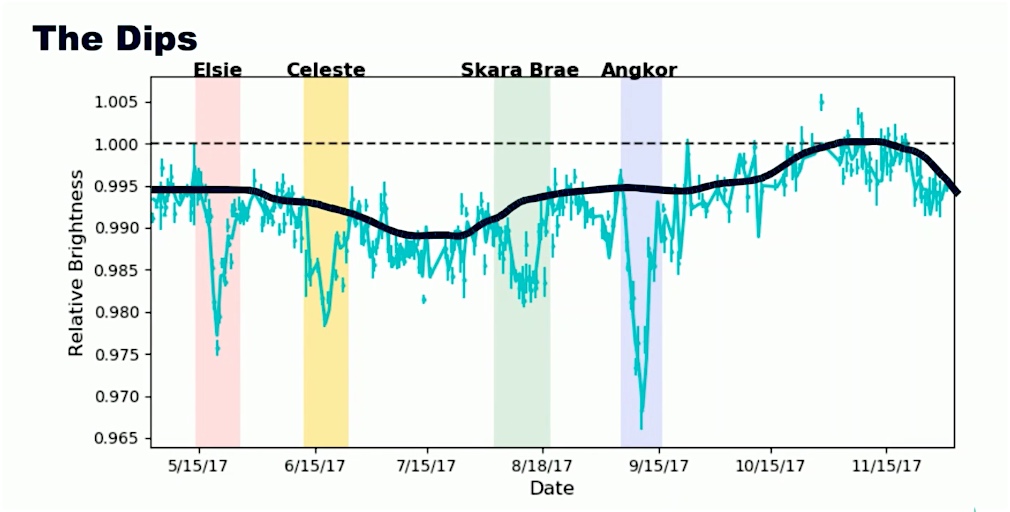What's up with Tabby's Star? Still an enigma, says ASU astronomer

A hypothetical view of the enigma known as Tabby's Star, which dims and brightens in irregular ways that astronomers are still trying to understand. Current models envision the star surrounded by a lumpy ring of dust that lies in our line of sight to it. The star may also have several comets, which is consistent with studies finding evidence for cometary activity within the system. Credit: NASA/JPL-Caltech
Dubbed by some as "the strangest star in the universe," the star known as KIC 8462852, Boyajian's Star, or Tabby's Star, is a little hotter than the sun and a bit brighter intrinsically. The star lies almost 1,500 light-years away from Earth in the constellation of Cygnus the Swan.
Sounds pretty ordinary, right?
Not at all. What makes this star so notable are large changes in its apparent brightness, by up to 20 percent. Moreover, these changes occur at irregular intervals and last days or weeks. In addition, the star also appears to be dimming and brightening steadily over a scale of years.
Citizen scientists using data from the Kepler Space Telescope first discovered brightness dips in 2015. Since then the star has been observed with ground-based telescopes around the world.
"Tabby's Star continues to pose puzzles," said Eva Bodman, a postdoctoral astronomer at Arizona State University's School of Earth and Space Exploration. She recently reported on observations of the star at the American Astronomical Society's summer meeting in Denver.
Last year, a ground-based monitoring campaign of the star with the Las Cumbres Observatory Global Telescope led by astronomer Tabetha Boyajian of Louisiana State University (and funded by Kickstarter backers) identified four brightness dips. These were named Elsie, Celeste, Skara Brae, and Angkor. Earlier this year two more dips were spotted and dubbed Caral-Supe and Evangeline.
"Our observations show that the dips that come and go over a few weeks are produced by dust," Bodman said. Dust is likely also the cause of the more gradual changes in brightness, but there's an important difference between the two kinds of dust.
"These new dips were observed at multiple wavelengths and clearly showed deeper dips at blue wavelengths than in red and in the near infrared," Bodman noted. "Larger depths at shorter, bluer wavelengths indicates small-grain dust."
The light curve for Tabby's Star in 2017 displays two kinds of changes in apparent brightness. The highlighted and named parts show brief drops in brightness. But there is also a more gradual change (black line) where the brightness slowly decreases and then returns. Even though these both happen at the same time, the different kinds of brightness changes are caused by different kinds of dust. Credit: Eva Bodman/ASU
That suggests that whatever process is creating these dust particles is going on currently.
As Bodman explained, "The dust is very small — like smoke particles from a campfire — and that means it was created recently. Particles that small get blown out of a star's vicinity in a year or so, driven away by the pressure of starlight."
On the other hand, the dust causing the more gradual brightness changes has a different spectrum which points to larger grains and probably a different origin. However, as with the small dust grains, astronomers are not sure what is producing it.
In the same scientific session as Bodman's presentation was one by two high-school students from the Thacher School in Ojai, California. Their data were collected independently, yet were consistent with the results Bodman found.
So where do these details leave astronomers' picture of Tabby's Star?
"This all suggests that the dust cloud obscuring the star is extremely complex along our line of sight to it," Bodman said. "We're seeing different parts of the dust cloud as they drift in front of the star.
"We need more observations to explain how the dust is being produced and to develop a clear astrophysical picture of what's happening at Tabby's Star."
Stay tuned.
More Science and technology

ASU-led space telescope is ready to fly
The Star Planet Activity Research CubeSat, or SPARCS, a small space telescope that will monitor the flares and sunspot activity…

ASU at the heart of the state's revitalized microelectronics industry
A stronger local economy, more reliable technology, and a future where our computers and devices do the impossible: that’s the…

Breakthrough copper alloy achieves unprecedented high-temperature performance
A team of researchers from Arizona State University, the U.S. Army Research Laboratory, Lehigh University and Louisiana State…


